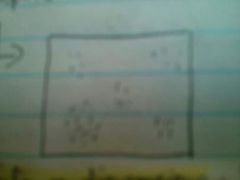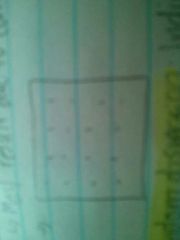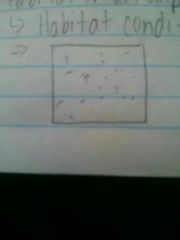![]()
![]()
![]()
Use LEFT and RIGHT arrow keys to navigate between flashcards;
Use UP and DOWN arrow keys to flip the card;
H to show hint;
A reads text to speech;
26 Cards in this Set
- Front
- Back
- 3rd side (hint)
|
Population Size |
The number of individuals of a specific species occupying a given area at a given time. |
|
|
|
Population Density |
The number of individuals of the same species that occupy per volume. |
|
|
|
Population Dispersion |
The general pattern in which individuals are distributed through a specific area. |
Clumped, uniform, random |
|
|
Clumped Dispersion |

The pattern in which individuals in a population are more concentrated in certain parts of habitat. |
|
|
|
Uniform Dispersion |

Individuals are evenly dispersed throughout the habitat. |
|
|
|
Random Dispersion |

Individuals are spread throughout a habitat in an unpredictable and patternless manner. |
|
|
|
Natality |
Number of births per unit of time. |
|
|
|
Mortality |
Number of deaths per unit of time. |
|
|
|
Immigration |
Number of individuals that move into an existing population per unit of time. |
|
|
|
Emigration |
The number of individuals that move away from an existing population per unit of time. |
|
|
|
Per Capita Growth Rate |
The change in population size relative to the initial size of population per unit of time. |
|
|
|
Open Population |
A population in which change in size and density is determined by natality, mortality, emigration, and immigration. |
|
|
|
Closed Populations |
A population in which change in size and density is determined by natality and mortality alone. |
|
|
|
Exponential Growth |
A pattern of population growth in which the population size increases by a fixed rate per unit of time. |
|
|
|
Environmental Influence |
Any factor that limits the populations ability to reach its biotic potential when it nears or exceeds the environmental carrying capacity. |
|
|
|
Logistic Growth |
A model of population growth describing growth that levels off as the size of the population approaches it's carrying capacity. |
|
|
|
Lag Phase |
Initial stage in which a population's growth rates are slow as a result of a smaller population size. |
|
|
|
Log Phase |
The stage in which growth rates are very rapid (and steady). |
|
|
|
Stationary Phase |
The phase at which population rates reach zero, as the population size reaches carrying capacity and stabalizes. |
|
|
|
Density Dependant Factor |
A factor that influences a population at a particular density. |
|
|
|
Intraspecific Competition |
Individuals of the same species rely on the same resources for survival. |
|
|
|
Predation |
An ecological interaction in which a predator kills and consumes a prey. |
|
|
|
Minimum Viable Population Size |
The smallest number of individuals needed for a population to continue for a certain amount of time. |
|
|
|
Density Independent Factors |
A factor that has the same influence on a population at any density. |
|
|
|
K-Selected Organism |
An organism that is adapted to survive at or near the carrying capacity of the environment. |
|
|
|
R-Selected Organism |
An organism that is adapted to increase population size randomly. |
|

